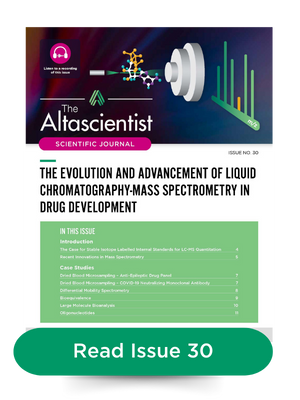ISSUE NO. 30 — The Evolution and Advancement of Liquid Chromatography-Mass Spectrometry in Drug Development

The drug development landscape is constantly evolving, with science and technology advancing hand-in-hand to improve the essential steps of determining drug concentration profiles and the characterization of drug transformation products. The ultimate goal is to better understand drug distribution, metabolism, and pharmacokinetic characteristics, and to present regulatory bodies with a complete and comprehensive submission package driven by current guidelines.
To this end, liquid chromatography (LC) coupled with mass spectrometry (MS) via an atmospheric pressure ionization (API) interface is a well-established analytical approach to support each phase of drug development, from early discovery through to clinical studies.
In Issue 30 of The Altascientist, we explore the numerous benefits of incorporating a stable isotope labelled internal standard for quantitative LC-MS, and detail recent advances in MS technology, including:
• stable isotope labelled internal standards (SLIS) for LC-MS quantitation
• Dried blood microsampling
• anti-epileptic drug panel
• COVID-19 neutralizing monoclonal antibodies
• differential mobility spectrometry
• bioequivalence
• large molecule bioanalysis
• oligonucleotides
Also included are several case studies, which exemplify novel bioanalytical workflows that are required to meet the challenges faced in both nonclinical and clinical development, across a variety of drug classes.
What is Liquid Chromatography-Mass Spectrometry?
The mainstream adoption of the LC-MS approach for the support of drug development initiatives originated in the early 1990s, pioneered by the triple-stage quadrupole (QqQ) platform. To this day, the QqQ architecture remains the gold standard for drug quantitation in biological fluids due to the unique nature by which MS/MS is performed.
Specifically, ionized precursor ions with a targeted mass-to-charge ratio (m/z) are transmitted through the first resolving quadrupole (Q1) and axially accelerated into a collision cell (q) containing an inert gas (N2 or Ar). The resulting collision-induced fragmentation leads to the production of progeny ions whose profile represents a fingerprint unique to that of the selected precursor. Progeny ions of a specific m/z can then be transmitted from the collision cell through the third resolving quadrupole (Q3) for detection. The scan function representing precursor ion selection with subsequent collision-induced dissociation and detection of a specific progeny ion is often referred to as multiple (or selected) reaction monitoring (MRM or SRM, respectively), and is single-handedly responsible for the mainstream adoption of the QqQ platform for quantitative mass spectrometry.
Over the years, advancements in LC-MS technology have been required to meet the ever-increasing complexities of assay demands. And the ubiquitous leveraging of LC-MS may largely be attributed to the following characteristics:
• high sensitivity with broad dynamic range and selectivity from interferences, particularly when incorporating a tandem mass spectrometric (i.e., MS/MS) approach;
• a near-universal and thermodynamically favorable electrospray ionization process that facilitates the transport of analyte ions from the condensed state of LC into the gas phase for MS detection; and
• the ability to support multiplexing capabilities due to rapid MS/MS scanning and chromatographic separation.
Explore all issues of The Altascientist in our Resource Center. And don’t forget to subscribe to “The Altascientist: Audiobooks” on Spotify, Apple Podcasts, or wherever you get your audio content.